Chechnya
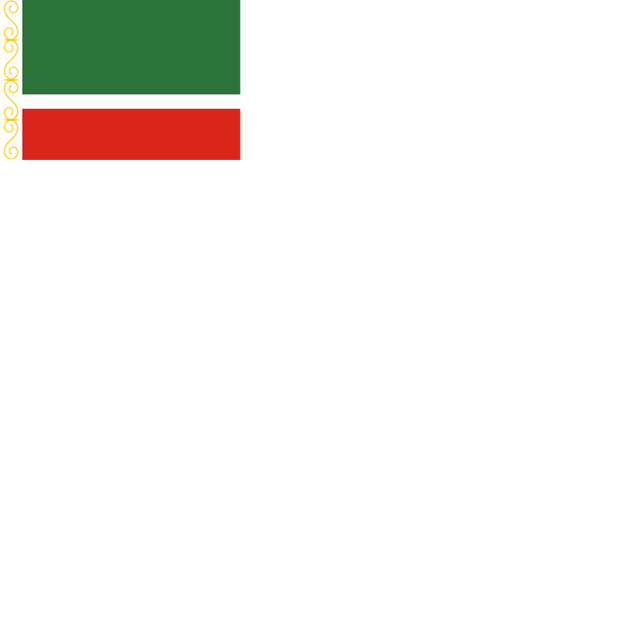
Chechnya

Chechen Republic | |
|---|---|
Republic | |
| Чеченская Республика | |
| Other transcription(s) | |
| • Chechen | Нохчийн Республика |
| Anthem: Shatlak's Song[3] | |
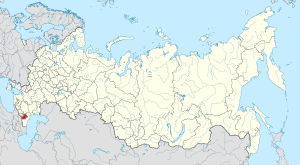 | |
| Coordinates:43°24′N 45°43′E [142] | |
| Country | Russia |
| Federal district | North Caucasian[1] |
| Economic region | North Caucasus[2] |
| Established | January 10, 1993[4] |
| Capital | Grozny |
| Government | |
| • Body | Parliament[5] |
| • Head[5] | Ramzan Kadyrov[6] |
| Area | |
| • Total | 17,300 km2(6,700 sq mi) |
| Area rank | 76th |
| Population | |
| • Estimate (2018)[8] | 1,436,981 |
| • Urban | 32.1% |
| Time zone | UTC+3 (MSK [9]) |
| ISO 3166 code | RU-CE |
| License plates | 95 |
| OKTMO ID | 96000000 |
| Official languages | Russian;[10]Chechen[11] |
| Website | http://chechnya.gov.ru [143] |
Chechnya (/ˈtʃɛtʃniə/; Russian: Чечня́, romanized: Chechnyá; Chechen: Нохчийчоь, Noxçiyçö), officially the Chechen Republic (/ˈtʃɛtʃɪn/; Russian: Чече́нская Респу́блика, romanized: Chechénskaya Respúblika; Chechen: Нохчийн Республика, Noxçiyn Respublika), is a federal subject (a republic) of Russia.
It is a Federal Subject of Russia located in the North Caucasus, and within 100 kilometres (62 miles) of the Caspian Sea.[12] The capital of the republic is the city of Grozny. As of the 2010 Russian Census, the republic was reported to have a population of 1,268,989 people;[13] however, that number has been questioned by multiple demographers, who think such population growth after two deadly wars is highly implausible.[14][15]
After the dissolution of the Soviet Union in 1991, the Chechen-Ingush ASSR was split into two parts: the Republic of Ingushetia and the Chechen Republic. The latter proclaimed the Chechen Republic of Ichkeria, which sought independence. Following the First Chechen War with Russia, Chechnya gained de facto independence as the Chechen Republic of Ichkeria. Russian federal control was restored during the Second Chechen War. Since then there has been a systematic reconstruction and rebuilding process, though sporadic fighting continues to take place in the mountains and southern regions into 2019.[16][17][18][19][20][21]
Chechen Republic | |
|---|---|
Republic | |
| Чеченская Республика | |
| Other transcription(s) | |
| • Chechen | Нохчийн Республика |
| Anthem: Shatlak's Song[3] | |
 | |
| Coordinates:43°24′N 45°43′E [142] | |
| Country | Russia |
| Federal district | North Caucasian[1] |
| Economic region | North Caucasus[2] |
| Established | January 10, 1993[4] |
| Capital | Grozny |
| Government | |
| • Body | Parliament[5] |
| • Head[5] | Ramzan Kadyrov[6] |
| Area | |
| • Total | 17,300 km2(6,700 sq mi) |
| Area rank | 76th |
| Population | |
| • Estimate (2018)[8] | 1,436,981 |
| • Urban | 32.1% |
| Time zone | UTC+3 (MSK [9]) |
| ISO 3166 code | RU-CE |
| License plates | 95 |
| OKTMO ID | 96000000 |
| Official languages | Russian;[10]Chechen[11] |
| Website | http://chechnya.gov.ru [143] |
History
Origin of Chechnya's population
According to Leonti Mroveli, the 11th-century Georgian chronicler, the word Caucasian is derived from the Vainakh ancestor Kavkas.[22]
According to George Anchabadze of Ilia State University
The Vainakhs are the ancient natives of the Caucasus. It is noteworthy, that according to the genealogical table drawn up by Leonti Mroveli, the legendary forefather of the Vainakhs was "Kavkas", hence the name Kavkasians, one of the ethnicons met in the ancient Georgian written sources, signifying the ancestors of the Chechens and Ingush. As appears from the above, the Vainakhs, at least by name, are presented as the most "Caucasian" people of all the Caucasians (Caucasus – Kavkas – Kavkasians) in the Georgian historical tradition.[23][24]
American linguist Johanna Nichols "has used language to connect the modern people of the Caucasus region to the ancient farmers of the Fertile Crescent" and her research suggests that "farmers of the region were proto-Nakh-Daghestanians." Nichols stated: "The Nakh–Dagestanian languages are the closest thing we have to a direct continuation of the cultural and linguistic community that gave rise to Western civilization." Henry Harpending, University of Utah, supports her claims.[25]
Prehistory
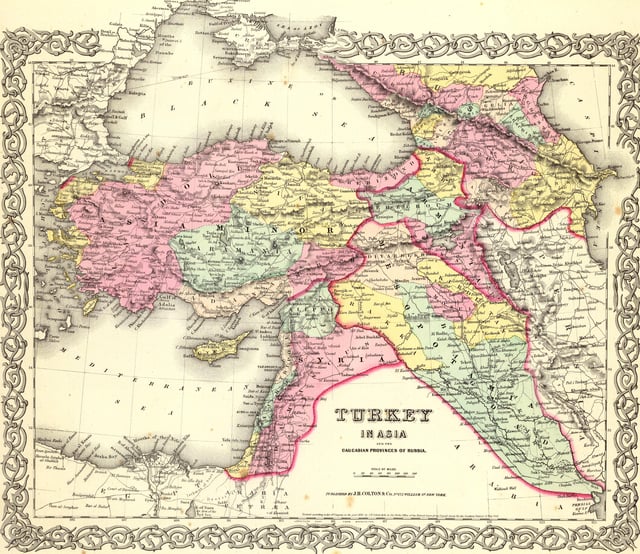
1855 Atlas Map of Turkey and the North Caucasus. Map of the American cartographer J.H.Colton. Top right corner, Chechnya is labeled as Gelia, with Chechen cities: Grosnaja (Grozny), Basdet and Leshistan cities: Andi, Metiro.
People living in prehistoric mountain cave settlements used tools, mastered fire, and used animal skins for warmth and other purposes.[26] Traces of human settlement that date back to 40,000 BC were found near Lake Kezanoi. Cave paintings, artifacts, and other archaeological evidence indicates continuous habitation for some 8,000 years.[26] In the Caucasian Epipaleolithic and early Caucasian Neolithic era, introduction of agriculture, irrigation, and the domestication of animals to the region.[27] Caucasian Neolithic. Pottery is known to the region. Old settlements near Ali-Yurt and Magas, discovered in the modern times, revealed tools made out of stone: stone axes, polished stones, stone knives, stones with holes drilled in them, clay dishes etc. Settlements made out of clay bricks discovered in the plains. In the mountains there were discovered settlements made out of stone and surrounded by walls; some of them dated back to 8000 BC.[28] Invention of the wheel (3000 BC), horseback riding, metal works (copper, gold, silver, iron), dishes, armor, daggers, knives, arrow tips. The artifacts were found near Nasare-Cort, Muzhichi, Ja-E-Bortz (also known as Surkha-khi), Abbey-Gove (also known as Nazran or Nasare)[28]
Pre-imperial era
In 900–1200, the kingdom in the center of the Caucasus splits into Alania and Noble Alania (known from Russian as Царственные Аланы). German scientist Peter Simon Pallas believed that Ingush people (Kist) were the direct descendants from Alania.[29] In the 1239, the Alania capital of Maghas was destroyed (both names known solely from Muslim Arabs) and Alan confederacy of the Northern Caucasian highlanders, nations, and tribes by Batu Khan (a Mongol leader and a grandson of Genghis Khan) "Magas was destroyed in the beginning of 1239 by the hordes of Batu Khan. Historically Magas was located at approximately the same place on which the new capital of Ingushetia is now built" – D.V.Zayats[30] In 1300–1400, war between the Alans, Tamerlan, Tokhtamysh, and the Battle of the Terek River. The Alan tribes build fortresses, castles, and defense walls locking the mountains from the invaders. Part of the lowland tribes occupied by Mongols. The insurgency against Mongols begins. In 1991 the Jordanian historian Abdul-Ghani Khassan presented the photocopy from old Arabic scripts claiming that Alania was in Chechnya and Ingushetia, and the document from Alanian historian Azdin Vazzar (1395–1460) who claimed to be from Nokhcho (Chechen) tribe of Alania.[31][32] In 1500, First Russian involvement in the Caucasus. 1558 Temryuk of Kabarda sends his emissaries to Moscow requesting help from Ivan the Terrible against Vainakh tribes. Ivan the Terrible marries Temryuk's daughter Maria Temryukovna. Alliance formed to gain the ground in the central Caucasus for the expanding Tsardom of Russia against stubborn Vainakh defenders. Chechnya was a nation in the Northern Caucasus that fought against foreign rule continually since the 15th century. The Chechens converted over the next few centuries to Sunni Islam, as Islam was associated with resistance to Russian encroachment.[33][34]
Imperial rule
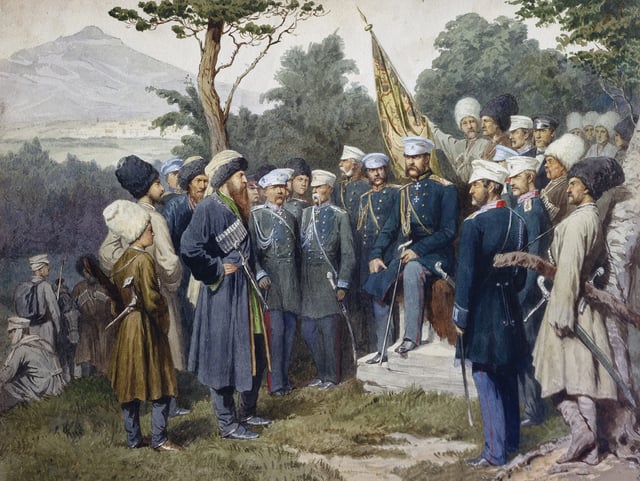
Imam Shamil of Chechnya and Dagestan surrendering to Russian general Baryatinsky in 1859; painting by Aleksey Kivshenko
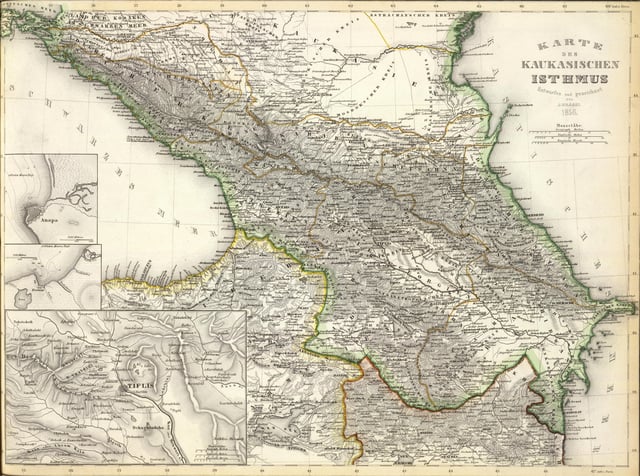
Map of the Caucasian Isthmusby J. Grassl, 1856
Peter I first sought to increase Russia's political influence in the Caucasus and the Caspian Sea at the expense of Safavid Persia when he launched the Russo-Persian War (1722–1723). Notable in Chechen history, this particular Russo-Persian War marked the first military encounter between Imperial Russia and the Vainakh. Russian forces succeeded in taking much of the Caucasian territories from Iran for several years.[35]
As the Russians took control of the Caspian corridor and moved into Persian-ruled Dagestan, Peter's forces ran into mountain tribes. Peter sent a cavalry force to subdue them, but the Chechens routed them.[35] In 1732, after Russia already ceded back most of the Caucasus to Persia, now led by Nader Shah, following the Treaty of Resht, Russian troops clashed again with Chechens in a village called Chechen-aul along the Argun River.[35] The Russians were defeated again and withdrew, but this battle is responsible for the apocryphal story about how the Nokchi came to be known as "Chechens"-the people ostensibly named for the place the battle had taken place. The name Chechen was however already used since as early as 1692.[35]
Under intermittent Persian rule since 1555, in 1783 the eastern Georgians of Kartl-Kakheti led by Erekle II and Russia signed the Treaty of Georgievsk. According to this treaty, Kartl-Kakheti received protection from Russia, and Georgia abjured any dependence on Iran.[36] In order to increase its influence in the Caucasus and to secure communications with Kartli and other minority Christian regions of the Transcaucasia which it considered useful in its wars against Persia and Turkey, the Russian Empire began conquering the Northern Caucasus mountains. The Russian Empire used Christianity to justify its conquests, allowing Islam to spread widely because it positioned itself as the religion of liberation from tsardom, which viewed Nakh tribes as "bandits".[37] The rebellion was led by Mansur Ushurma, a Chechen Naqshbandi (Sufi) sheikh—with wavering military support from other North Caucasian tribes. Mansur hoped to establish a Transcaucasus Islamic state under shari'a law. He was unable to fully achieve this because in the course of the war he was betrayed by the Ottomans, handed over to Russians, and executed in 1794.[38]
Following the forced ceding of the current territories of Dagestan, most of Azerbaijan, and Georgia by Persia to Russia, following the Russo-Persian War (1804–1813) and its outcoming Treaty of Gulistan, Russia significantly widened its foothold in the Caucasus at the expense of Persia.[39] Another successful Caucasus war against Persia several years later, starting in 1826 and ending in 1828 with the Treaty of Turkmenchay, and a successful war against Ottoman Turkey in 1828, enabled Russia to use a much larger portion of its army in subduing the natives of the North Caucasus.
The resistance of the Nakh tribes never ended and was a fertile ground for a new Muslim-Avar commander, Imam Shamil, who fought against the Russians from 1834 to 1859 (see Murid War). In 1859, Shamil was captured by Russians at aul Gunib. Shamil left Boysangur Benoiski,[40] a Chechen with one arm, one eye, and one leg, in charge of command at Gunib. Benoiski broke through the siege and continued to fight Russia for another two years until he was captured and killed by Russians. The Russian tsar hoped that by sparing the life of Shamil, the resistance in the North Caucasus would stop, but it did not. Russia began to use a colonization tactic by destroying Nakh settlements and building Cossack defense lines in the lowlands. The Cossacks suffered defeat after defeat and were constantly attacked by mountaineers, who were robbing them of food and weaponry.
The tsarists' regime used a different approach at the end of the 1860s. They offered Chechens and Ingush to leave the Caucasus for the Ottoman Empire (see Muhajir (Caucasus)). It is estimated that about 80% of Chechens and Ingush left the Caucasus during the deportation. It weakened the resistance which went from open warfare to insurgent warfare. One of the notable Chechen resistance fighters at the end of the 19th century was a Chechen abrek Zelimkhan Gushmazukaev and his comrade-in-arms Ingush abrek Sulom-Beck Sagopshinski. Together they built up small units which constantly harassed Russian military convoys, government mints, and government post-service, mainly in Ingushetia and Chechnya. Ingush aul Kek was completely burned when the Ingush refused to hand over Zelimkhan. Zelimkhan was killed at the beginning of the 20th century. The war between Nakh tribes and Russia resurfaced during the times of the Russian Revolution, which saw the Nakh struggle against Anton Denikin and later against the Soviet Union.
On December 21, 1917, Ingushetia, Chechnya, and Dagestan declared independence from Russia and formed a single state: "United Mountain Dwellers of the North Caucasus" (also known as the Mountainous Republic of the Northern Caucasus) which was recognized by major world powers. The capital of the new state was moved to Temir-Khan-Shura (Dagestan).[41][42][43] Tapa Tchermoeff, a prominent Chechen statesman, was elected the first prime minister of the state. The second prime minister elected was Vassan-Girey Dzhabagiev, an Ingush statesman, who also was the author of the constitution of the republic in 1917, and in 1920 he was re-elected for the third term. In 1921 the Russians attacked and occupied the country and forcefully absorbed it into the Soviet state. The Caucasian war for independence restarted, and the government went into exile.[44]
Soviet rule
During Soviet rule, Chechnya and Ingushetia were combined to form Chechen-Ingush Autonomous Soviet Socialist Republic. In the 1930s Chechnya was flooded with many Ukrainians fleeing the Holodomor. As a result, many of the Ukrainians settled in Chechen-Ingush ASSR permanently and survived the famine.[45]
Although over 50,000 Chechens and over 12,000 Ingush were fighting against Nazi Germany on the front line (including heroes of the USSR: Abukhadzhi Idrisov, Khanpasha Nuradilov, Movlid Visaitov), and although Nazi German troops were fought to a complete stop at two Chechen-Ingush ASSR cities Malgobek and Ordzhonikidze (renamed to Vladikavkaz) after capturing half of the Caucasus in less than a month; Chechens and Ingush were falsely accused as Nazi supporters and entire nations were deported during Operation Lentil to the Kazakh SSR (later Kazakhstan) in 1944 near the end of World War II where over 60% of Chechen and Ingush populations perished.[46][47] American historian Norman Naimark writes:
Troops assembled villagers and townspeople, loaded them onto trucks – many deportees remembered that they were Studebakers, fresh from Lend-Lease deliveries over the Iranian border – and delivered them at previously designated railheads. ...Those who could not be moved were shot. ...[A] few fighters aside, the entire Chechen and Ingush nations, 496,460 people, were deported from their homeland.[48]
The deportation was supposedly justified by the materials prepared by notorious NKVD officer Bogdan Kobulov accusing Chechens and Ingush in a mass conspiracy preparing rebellion and providing assistance to the German forces. Many of the materials were later proved to be fabricated.[49] Even distinguished Red Army officers who fought bravely against Germans (e.g. the commander of 255th Separate Chechen-Ingush regiment Movlid Visaitov, the first to contact American forces at Elbe river) were deported.[50] There is a theory that the real reason why Chechens and Ingush were deported is the desire of Russia to attack Turkey, a non-communist country, as Chechens and Ingush could impede such plans.[37] In 2004, the European Parliament recognized the deportation of Chechens and Ingush as an act of genocide.[51]
The territory of the Chechen-Ingush Autonomous Soviet Socialist Republic was divided between Stavropol Krai (where Grozny Okrug was formed), the Dagestan ASSR, the North Ossetian ASSR, and the Georgian SSR.
The Chechens and Ingush were allowed to return to their land after 1956 during de-Stalinization under Nikita Khrushchev[46] when Chechen-Ingush Autonomous Soviet Socialist Republic was restored but both boundaries and ethnic composition of the territory significantly changed. There were many (predominantly Russian) migrants from other parts of the Soviet Union, who often settled in the abandoned family homes of Chechens and Ingushes. The republic lost its Prigorodny District which transferred to North Ossetian ASSR but gained predominantly Russian Naursky District and Shelkovskoy District that is considered the homeland for Terek Cossacks.
The Russification policies towards Chechens continued after 1956, with Russian language proficiency required in many aspects of life to provide Chechens better opportunities for advancement in the Soviet system.[37]
On November 26, 1990, the Supreme Council of Chechen-Ingush ASSR adopted the "Declaration of State Sovereignty of the Chechen-Ingush Republic". This declaration was part of the reorganization of the Soviet Union. This new treaty would have been signed August 22, 1991, which would have transformed 15 republic states into more than 80. The August 19–21, 1991 Soviet coup d'état attempt led to the abandonment of this reorganization.[52]
With the impending dissolution of the Soviet Union in 1991, an independence movement, the Chechen National Congress, was formed, led by ex-Soviet Air Force general and new Chechen President Dzhokhar Dudayev. It campaigned for the recognition of Chechnya as a separate nation. This movement was opposed by Boris Yeltsin's Russian Federation, which argued that Chechnya had not been an independent entity within the Soviet Union—as the Baltic, Central Asian, and other Caucasian States had—but was part of the Russian Soviet Federative Socialist Republic and hence did not have a right under the Soviet constitution to secede. It also argued that other republics of Russia, such as Tatarstan, would consider seceding from the Russian Federation if Chechnya were granted that right. Finally, it argued that Chechnya was a major hub in the oil infrastructure of Russia and hence its secession would hurt the country's economy and energy access.
In the ensuing decade, the territory was locked in an ongoing struggle between various factions, usually fighting unconventionally and forgoing the position held by the several successive Russian governments through the current administration.
Chechen Wars
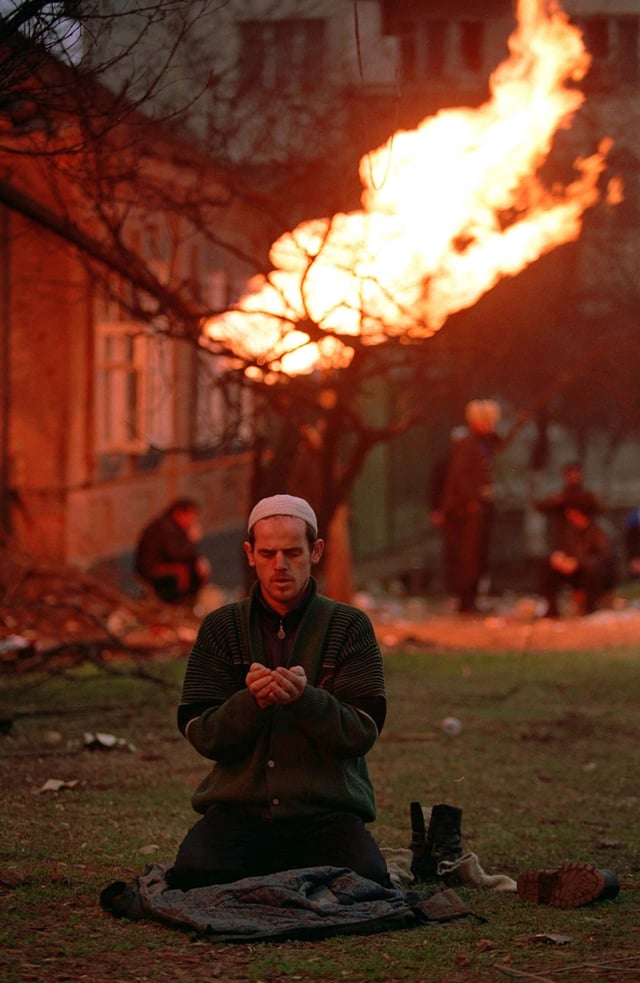
A Chechen man prays during the Battle of Grozny.
The First Chechen War took place from 1994 to 1996, when Russian forces attempted to regain control over Chechnya, which had declared independence in November 1991. Despite overwhelming numerical superiority in men, weaponry, and air support, the Russian forces were unable to establish effective permanent control over the mountainous area due to numerous successful full-scale battles and insurgency raids. In three months, Russia lost more tanks (over 1,997 tanks) in Grozny than during the Battle of Berlin in 1945.[53]
The Budyonnovsk hospital hostage crisis in 1995 shocked the Russian public and led to international condemnation of the Chechen rebels.
In April 1996 the first democratically elected president of Chechnya, Dzhokhar Dudayev, was killed by Russian forces using a booby trap bomb and a missile fired from a warplane after he was located by triangulating the position of a satellite phone he was using.[54]
The widespread demoralization of the Russian forces in the area and a successful offensive to re-take Grozny by Chechen rebel’s forces led by Aslan Maskhadov prompted Russian President Boris Yeltsin to declare a ceasefire in 1996, and sign a peace treaty a year later that saw a withdrawal of Russian forces.[55]
After the war, parliamentary and presidential elections took place in January 1997 in Chechnya and brought to power new President Aslan Maskhadov, chief of staff and prime minister in the Chechen coalition government, for a five-year term. Maskhadov sought to maintain Chechen sovereignty while pressing the Russian government to help rebuild the republic, whose formal economy and infrastructure were virtually destroyed.[56] Russia continued to send money for the rehabilitation of the republic; it also provided pensions and funds for schools and hospitals. Most of these funds were taken by Chechen authorities and divided between favored warlords. Nearly half a million people (40% of Chechnya's prewar population) had been internally displaced and lived in refugee camps or overcrowded villages.[57] There was an economic downturn. Two Russian brigades were permanently stationed in Chechnya.[57]
In lieu of the devastated economic structure, kidnapping emerged as the principal source of income countrywide, procuring over US$200 million during the three-year independence of the chaotic fledgling state,[58] although victims were rarely killed.[59] In 1998, 176 people were kidnapped, 90 of whom were released, according to official accounts. President Maskhadov started a major campaign against hostage-takers, and on October 25, 1998, Shadid Bargishev, Chechnya's top anti-kidnapping official, was killed in a remote-controlled car bombing. Bargishev's colleagues then insisted they would not be intimidated by the attack and would go ahead with their offensive. Political violence and religious extremism, blamed on "Wahhabism", was rife. In 1998, Grozny authorities declared a state of emergency. Tensions led to open clashes between the Chechen National Guard and Islamist militants, such as the July 1998 confrontation in Gudermes.
The War of Dagestan began on August 7, 1999, during which the Islamic International Brigade (IIPB) began an unsuccessful incursion into the neighboring Russian republic of Dagestan in favor of the Shura of Dagestan which sought independence from Russia.[60] In September, a series of apartment bombs that killed around 300 people in several Russian cities, including Moscow, were blamed on the Chechen separatists.[46] Some journalists contested the official explanation, instead blaming the Russian Secret Service for blowing up the buildings to initiate a new military campaign against Chechnya.[61] In response to the bombings, a prolonged air campaign of retaliatory strikes against the Ichkerian regime and a ground offensive that began in October 1999 marked the beginning of the Second Chechen War. Much better organized and planned than the first Chechen War, the Russian military took control over most regions. The Russian forces used brutal force, killing 60 Chechen civilians during a mop-up operation in Aldy, Chechnya on February 5, 2000. After the re-capture of Grozny in February 2000, the Ichkerian regime fell apart.[62][63]
Post-war reconstruction and insurgency

Postage stamp issued in 2009 by the Russian Post dedicated to Chechnya
Chechen rebels continued to fight Russian troops and conduct terrorist attacks.[64] In October 2002, 40–50 Chechen rebels seized a Moscow theater and took about 900 civilians hostage.[46] The crisis ended with 117 hostages and up to 50 rebels dead, mostly due to an unknown aerosol pumped throughout the building by Russian special forces to incapacitate the people inside.[65][66][67]
In September 2004, separatist rebels occupied a school in the town of Beslan, North Ossetia, demanding recognition of the independence of Chechnya and a Russian withdrawal. 1,100 people (including 777 children) were taken hostage. The attack lasted three days, resulting in the deaths of over 331 people, including 186 children.[46][68][69][70]
In response to the increasing terrorism, Russia tightened its grip on Chechnya and expanded its anti-terrorist operations throughout the region. Russia installed a pro-Russian Chechen regime. In 2003, a referendum was held on a constitution that reintegrated Chechnya within Russia but provided limited autonomy. According to the Chechen government, the referendum passed with 95.5% of the votes and almost 80% turnout.[71] The Economist was skeptical of the results, arguing that "few outside the Kremlin regard the referendum as fair".[72] After the 2004 school siege, Russian president Vladimir Putin announced sweeping security and political reforms, sealing borders in the Caucasus region and revealing plans to give the central government more power. He also vowed to take tougher action against domestic terrorism, including preemptive strikes against Chechen separatists.[46] In 2005 and 2006, prominent separatist leaders Aslan Maskhadov and Shamil Basayev were killed.
In April 2009, Russia ended its counter-terrorism operation and pulled out the bulk of its army.[75] The insurgency in the North Caucasus continued even after this date. The Caucasus Emirate has fully adopted the tenets of being a Salafist-takfiri jihadist group through its strict adherence to upholding wahabi, its obedience to the literal interpretation of the Quran and the Sunnah, and its complete rejection of traditional sunni, four imams, and awliya allah.[76]
Geography

The mountains in the area Sharoy
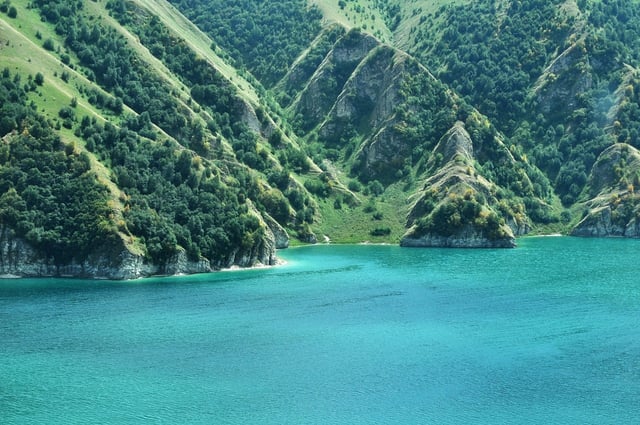
Lake Kezenoyam
Situated in the eastern part of the North Caucasus, partially in Eastern Europe, Chechnya is surrounded on nearly all sides by Russian Federal territory. In the west, it borders North Ossetia and Ingushetia, in the north, Stavropol Krai, in the east, Dagestan, and to the south, Georgia. Its capital is Grozny.
Area: 17,300 sq km (6680 sq mi)
Borders: Internal: Dagestan (NE) Ingushetia (W) North Ossetia–Alania (W) Stavropol Krai (NW) Foreign: Georgia (Kakheti and Mtskheta-Mtianeti) (S)
Rivers:
Terek
Sunzha
Argun
Cities and towns with over 20,000 people

Map of Chechen Republic (Chechnya)
Grozny (capital)
Shali
Urus-Martan
Gudermes
Argun
Administrative divisions
Informal divisions
There are no true districts of Chechnya, but many believe that the different dialects of the Chechen language define different districts. The main dialects are: Grozny, also known as the Dzhokhar dialect, is the dialect of people who live in and in some towns around Grozny. Naskhish, a dialect spoken to the northeast of Chechnya. The most notable difference in this dialect is the addition of the letters "ȯ", "ј" and "є" Day, pronounced like the word 'die' is spoken in a small section of the south, around and in the town of Day.
There are other dialects which are believed to define districts, but because these areas are so isolated, not much research has been done on these areas.
Demographics
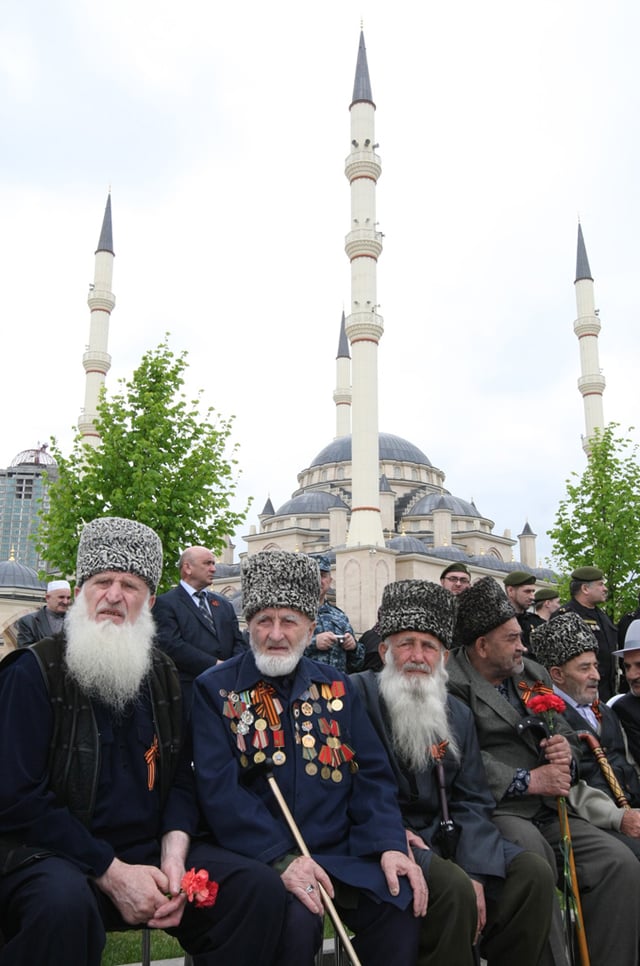
Chechen World War II veterans during celebrations on the 66th anniversary of victory in the Great Patriotic War
According to the 2010 Census, the population of the republic is 1,268,989,[13] up from 1,103,686 recorded in the 2002 Census.[77] As of the 2010 Census,[13] Chechens at 1,206,551 make up 95.3% of the republic's population. Other groups include Russians (24,382, or 1.9%), Kumyks (12,221, or 1%), Ingush (1,296 or 0.1%) and a host of smaller groups, each accounting for less than 0.5% of the total population. The Armenian community, which used to number around 15,000 in Grozny alone, has dwindled to a few families.[78] The Armenian church of Grozny was demolished in 1930. The birth rate was 25.41 in 2004. (25.7 in Achkhoi Martan, 19.8 in Groznyy, 17.5 in Kurchaloi, 28.3 in Urus Martan and 11.1 in Vedeno). According to the Chechen State Statistical Committee, Chechnya's population had grown to 1.205 million in January 2006.[79]
At the end of the Soviet era, ethnic Russians (including Cossacks) comprised about 23% of the population (269,000 in 1989).
According to some Russian sources, from 1991 to 1994 tens of thousands of people of non-Chechen ethnicity (mostly Russians, Ukrainians, and Armenians) left the republic amidst reports of violence and discrimination against the non-Chechen population, as well as widespread lawlessness and ethnic cleansing under the government of Dzhokhar Dudayev.[80][81]
However, regarding this exodus, there is an alternative view. According to the Russian economists Boris Lvin and Andrei Iliaronov,
The Chechen authorities are regularly accused of crimes against the population, especially the Russian-speaking people. However, before the current war the emigration of the Russian-speaking population from Chechnya was no more intense than that from Kalmykia, Tuva and Sakha-Yakutia. In Grozny itself there remained a 200,000 strong Russian-speaking population which did not hasten to leave it.[82][83]
The languages used in the Republic are Chechen and Russian. Chechen belongs to the Vaynakh or North-central Caucasian language family, which also includes Ingush and Batsb. Some scholars place it in a wider North Caucasian languages.
According to Russian media, Chechnya has the lowest alcohol consumption in Russia.[84]
Settlements
Vital statistics

Ethnolinguistic groups in the Caucasus region
- Source: Russian Federal State Statistics Service [144]
| Average population (x 1000) | Live births | Deaths | Natural change | Crude birth rate (per 1000) | Crude death rate (per 1000) | Natural change (per 1000) | Total fertility rate | |
|---|---|---|---|---|---|---|---|---|
| 2003 | 1,117 | 27,774 | 7,194 | 20 580 | 24.9 | 6.4 | 18.4 | |
| 2004 | 1,133 | 28,496 | 6,347 | 22,149 | 25.2 | 5.6 | 19.5 | |
| 2005 | 1,150 | 28,652 | 5,857 | 22,795 | 24.9 | 5.1 | 19.8 | |
| 2006 | 1,167 | 27,989 | 5,889 | 22,100 | 24.0 | 5.0 | 18.9 | |
| 2007 | 1,187 | 32,449 | 5,630 | 26,819 | 27.3 | 4.7 | 22.6 | |
| 2008 | 1,210 | 35,897 | 5,447 | 30,450 | 29.7 | 4.5 | 25.2 | |
| 2009 | 1,235 | 36,523 | 6,620 | 29,903 | 29.6 | 5.4 | 24.2 | 3.43 |
| 2010 | 1,260 | 37,753 | 7,042 | 30,711 | 30.0 | 5.6 | 24.4 | 3.45 |
| 2011 | 1,289 | 37,335 | 6,810 | 30,525 | 28.9 | 5.3 | 23.6 | 3.36 |
| 2012 | 1,314 | 34,385 | 7,192 | 27,193 | 26.2 | 5.5 | 20.7 | 3.08 |
| 2013 | 1,336 | 32,963 | 6,581 | 26,382 | 24.7 | 4.9 | 19.8 | 2.93 |
| 2014 | 1,358 | 32,949 | 6,864 | 26,085 | 24.3 | 5.1 | 19.2 | 2.91 |
| 2015 | 1,383 | 32,057 | 6,728 | 25,329 | 23.2 | 4.9 | 18.3 | 2.80 |
| 2016 | 1,404 | 29,893 | 6,630 | 23,263 | 21.3 | 4.7 | 16.6 | 2.62 |
| 2017 | 1,425 | 29,890 | 6,586 | 23,304 | 21.0 | 4.6 | 16.4 | 2.73 |
| 2018 | 1,444 | 29,227 | 6,110 | 23,117 | 20.2 | 4.2 | 16.0 |
Note: TFR 2009–12 source.[85]
Ethnic groups
(in the territory of modern Chechnya)[86]
| Ethnic group | 1926 Census | 1939 Census2 | 1959 Census2 | 1970 Census | 1979 Census | 1989 Census | 2002 Census | 2010 Census1 | ||||||||
|---|---|---|---|---|---|---|---|---|---|---|---|---|---|---|---|---|
| Number | % | Number | % | Number | % | Number | % | Number | % | Number | % | Number | % | Number | % | |
| Chechens | 293,298 | 67.3% | 360,889 | 58.0% | 238,331 | 39.7% | 499,962 | 54.7% | 602,223 | 60.1% | 715,306 | 66.0% | 1,031,647 | 93.5% | 1,206,551 | 95.3% |
| Russians | 103,271 | 23.5% | 213,354 | 34.3% | 296,794 | 49.4% | 327,701 | 35.8% | 307,079 | 30.6% | 269,130 | 24.8% | 40,645 | 3.7% | 24,382 | 1.9% |
| Kumyks | 2,217 | 0.5% | 3,575 | 0,6% | 6,865 | 0.8% | 7,808 | 0.8% | 9,591 | 0.9% | 8,883 | 0.8% | 12,221 | 1.0% | ||
| Avars | 830 | 0.2% | 2,906 | 0.5% | 4,196 | 0.5% | 4,793 | 0.5% | 6,035 | 0.6% | 4,133 | 0.4% | 4,864 | 0.4% | ||
| Nogays | 162 | 0.0% | 1,302 | 0.2% | 5,503 | 0.6% | 6,079 | 0.6% | 6,885 | 0.6% | 3,572 | 0.3% | 3,444 | 0.3% | ||
| Ingushes | 798 | 0.2% | 4,338 | 0.7% | 3,639 | 0.6% | 14,543 | 1.6% | 20,855 | 2.1% | 25,136 | 2.3% | 2,914 | 0.3% | 1,296 | 0.1% |
| Ukrainians | 11,474 | 2.6% | 8,614 | 1.4% | 11,947 | 2.0% | 11,608 | 1.3% | 11,334 | 1.1% | 11,884 | 1.1% | 829 | 0.1% | 13,716 | 1.1% |
| Armenians | 5,978 | 1.4% | 8,396 | 1.3% | 12,136 | 2.0% | 13,948 | 1.5% | 14,438 | 1.4% | 14,666 | 1.4% | 424 | 0.0% | ||
| Others | 18,840 | 4.13% | 18,646 | 3.0% | 37,550 | 6.3% | 30,057 | 3.3% | 27,621 | 2.8% | 25,800 | 2.4% | 10,639 | 1.0% | ||
| 12,515 people were registered from administrative databases, and could not declare an ethnicity. It is estimated that the proportion of ethnicities in this group is the same as that of the declared group.[87]|2Note that practically all Chechen and Ingush people were deported to Central Asia or killed in 1944. They were, however, allowed to return to the Northern Caucasus in 1957 by Nikita Khrushchev. See Deportation of the Chechens and Ingush | ||||||||||||||||
Religion
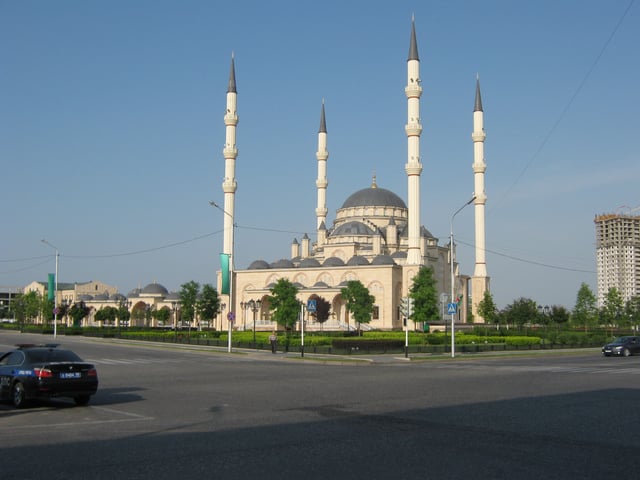
Akhmad Kadyrov Mosque in Grozny
Islam is the predominant religion in Chechnya, practiced by 95% of those polled in Grozny in 2010.[88] Chechens are overwhelmingly adherents to the Shafi'i Madhhab of Sunni Islam,[89] the republic having converted to Islam between the 16th and the 19th centuries. Due to historical importance, many Chechens are Sufis, of either the Qadiri or Naqshbandi orders. Most of the population follows either the Shafi'i or the Hanafi,[90] schools of jurisprudence, fiqh. The Shafi'i school of jurisprudence has a long tradition among the Chechens,[91] and thus it remains the most practiced.[92]
The once-strong Russian minority in Chechnya, mostly Terek Cossacks and estimated as numbering approximately 25,000 in 2012, are predominantly Russian Orthodox, although presently only one church exists in Grozny. In August 2011, Archbishop Zosima of Vladikavkaz and Makhachkala performed the first mass baptism ceremony in the history of the Chechen Republic in the Terek River of Naursky District in which 35 citizens of Naursky and Shelkovsky districts were converted to Orthodoxy.[93]
On 19 January 2015, 12 days after the Charlie Hebdo shooting, a march took place in Grozny against the publication of caricatures of the prophet Mohammed.[94] The Chechen Ministry of Interior reported that more than a million people participated, while according to the sources of Caucasian Knot the number was between 350,000 and 500,000.[95]
Politics
Since 1990, the Chechen Republic has had many legal, military, and civil conflicts involving separatist movements and pro-Russian authorities. Today, Chechnya is a relatively stable federal republic, although there is still some separatist movement activity. Its regional constitution entered into effect on April 2, 2003, after an all-Chechen referendum was held on March 23, 2003. Some Chechens were controlled by regional teips, or clans, despite the existence of pro- and anti-Russian political structures.
Regional government
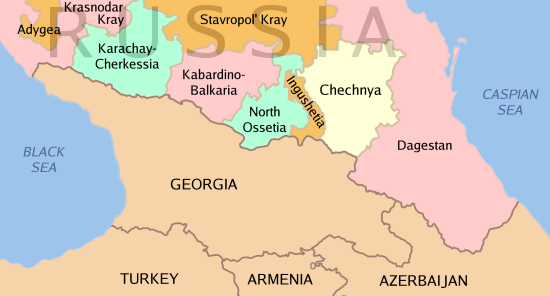
Chechnya and Caucasus map
The former separatist religious leader (mufti) Akhmad Kadyrov, looked upon as a traitor by many separatists, was elected president with 83% of the vote in an internationally monitored election on October 5, 2003. Incidents of ballot stuffing and voter intimidation by Russian soldiers and the exclusion of separatist parties from the polls were subsequently reported by the Organization for Security and Co-operation in Europe (OSCE) monitors. On May 9, 2004, Kadyrov was assassinated in Grozny football stadium by a landmine explosion that was planted beneath a VIP stage and detonated during a parade, and Sergey Abramov was appointed to the position of acting prime minister after the incident. However, since 2005 Ramzan Kadyrov (son of Akhmad Kadyrov) has been the caretaker prime minister, and in 2007 was appointed as the new president. Many allege he is the wealthiest and most powerful man in the republic, with control over a large private militia referred to as the Kadyrovtsy. The militia, which began as his father's security force, has been accused of killings and kidnappings by human rights organizations such as Human Rights Watch.
In 2009, the US government financed American organization Freedom House included Chechnya in the "Worst of the Worst" list of most repressive societies in the world, together with Burma, North Korea, Tibet, and others.[96]
Separatist government

Shamil Basayev, Chechen militant Islamist and a leader of the Chechen rebel movement
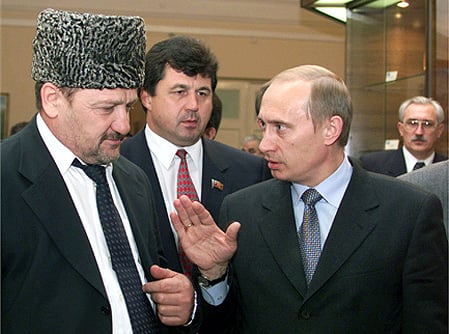
Akhmad Kadyrov, former separatist and head of the Chechen Republic, with Russian President Vladimir Putin
In addition to the Russian regional government, there was a separatist Ichkeria government that was not recognized by any state (although members have been given political asylum in European and Arab countries, as well as the United States).
Ichkeria was a member of the Unrepresented Nations and Peoples Organization between 1991 and 2010.[97] Former president of Georgia Zviad Gamsakhurdia deposed in a military coup of 1991 and a participant of the Georgian Civil War, recognized the independence of the Chechen Republic of Ichkeria in 1993.[98] Diplomatic relations with Ichkeria were also established by the partially recognized Islamic Emirate of Afghanistan under the Taliban government on January 16, 2000. This recognition ceased with the fall of the Taliban in 2001.[99] However, despite Taliban recognition, there were no friendly relations between the Taliban and Ichkeria—Maskhadov rejected their recognition, stating that the Taliban were illegitimate.[100] Ichkeria also received vocal support from the Baltic countries, a group of Ukrainian nationalists and Poland; Estonia once voted to recognize, but the act never was followed through due to pressure applied by both Russia and the EU.[100][101][102]
The president of this government was Aslan Maskhadov, the Foreign Minister was Ilyas Akhmadov, who was the spokesman for Maskhadov. Aslan Maskhadov had been elected in an internationally monitored election in 1997 for 4 years, which took place after signing a peace agreement with Russia. In 2001 he issued a decree prolonging his office for one additional year; he was unable to participate in the 2003 presidential election since separatist parties were barred by the Russian government, and Maskhadov faced accusations of terrorist offenses in Russia. Maskhadov left Grozny and moved to the separatist-controlled areas of the south at the onset of the Second Chechen War. Maskhadov was unable to influence a number of warlords who retain effective control over Chechen territory, and his power was diminished as a result. Russian forces killed Maskhadov on March 8, 2005, and the assassination of Maskhadov was widely criticized since it left no legitimate Chechen separatist leader with whom to conduct peace talks. Akhmed Zakayev, Deputy Prime Minister and a Foreign Minister under Maskhadov, was appointed shortly after the 1997 election and is currently living under asylum in England. He and others chose Abdul Khalim Saidullayev, a relatively unknown Islamic judge who was previously the host of an Islamic program on Chechen television, to replace Maskhadov following his death. On June 17, 2006, it was reported that Russian special forces killed Abdul Khalim Saidullayev in a raid in a Chechen town Argun.
The successor of Saidullayev became Doku Umarov. On October 31, 2007, Umarov abolished the Chechen Republic of Ichkeria and its presidency and in its place proclaimed the Caucasian Emirate with himself as its Emir.[103] This change of status has been rejected by many Chechen politicians and military leaders who continue to support the existence of the republic.
Human rights
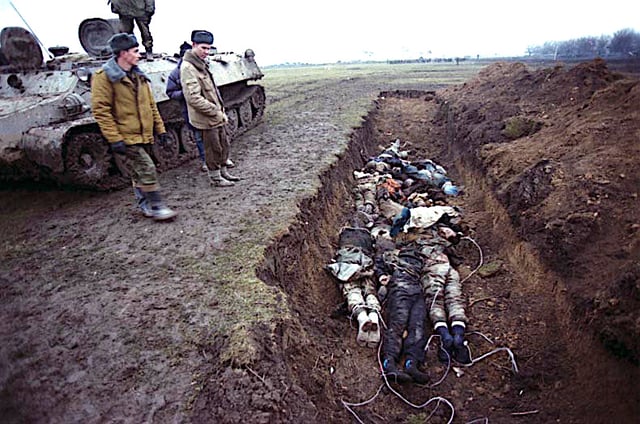
Mass grave in Chechnya (2000)

Chechen leader Ramzan Kadyrov in 2018
The Internal Displacement Monitoring Centre reports that after hundreds of thousands of ethnic Russians and Chechens fled their homes following inter-ethnic and separatist conflicts in Chechnya in 1994 and 1999, more than 150,000 people still remain displaced in Russia today.[104]
On September 1, 1997, Criminal Code reportedly being implemented in the Chechen Republic-Ichkeriya, Article 148 punishes "anal sexual intercourse between a man and a woman or a man and a man". For first- and second-time offenders, the punishment is caning. A third conviction leads to the death penalty, which can be carried out in a number of ways including stoning or beheading.[105]
Human rights groups criticized the conduct of the 2005 parliamentary elections as unfairly influenced by the central Russian government and military.[106]
In 2006 Human Rights Watch reported that pro-Russian Chechen forces under the command of Ramzan Kadyrov, as well as federal police personnel, used torture to get information about separatist forces. "If you are detained in Chechnya, you face a real and immediate risk of torture. And there is little chance that your torturer will be held accountable", said Holly Cartner, Director of the Europe and Central Asia division of the Human Rights Watch.[107]
On February 1, 2009, The New York Times released extensive evidence to support allegations of consistent torture and executions under the Kadyrov government. The accusations were sparked by the assassination in Austria of a former Chechen rebel who had gained access to Kadyrov's inner circle, 27-year-old Umar Israilov.[108]
On July 1, 2009, Amnesty International released a detailed report covering the human rights violations committed by the Russian Federation against Chechen citizens. Among the most prominent features was that those abused had no method of redress against assaults, ranging from kidnapping to torture, while those responsible were never held accountable. This led to the conclusion that Chechnya was being ruled without law, being run into further devastating destabilization.[109]
On March 10, 2011, Human Rights Watch reported that since Chechenization, the government has pushed for enforced Islamic dress code.[110] The president Ramzan Kadyrov is quoted as saying "I have the right to criticize my wife. She doesn't. With us [in Chechen society], a wife is a housewife. A woman should know her place. A woman should give her love to us [men]... She would be [man's] property. And the man is the owner. Here, if a woman does not behave properly, her husband, father, and brother are responsible. According to our tradition, if a woman fools around, her family members kill her... That's how it happens, a brother kills his sister or a husband kills his wife... As a president, I cannot allow for them to kill. So, let women not wear shorts...".[111] He has also openly defended honor killings on several occasions.[112]
On July 9, 2017, Russian newspaper Novaya Gazeta reported that a number of people were subject to an extrajudicial execution on the night of January 26, 2017. It published 27 names of the people known to be dead, but stressed that the list is "not all [of those killed]"; the newspaper asserted that 50 people may have been killed in the execution.[113] Some of the dead were gay, but not all; the deaths appeared to have been triggered by the death of a policeman,[113] and according to the author of the report, Elena Milashina, were executed for terrorism.[114]
Gay concentration camps
Economy
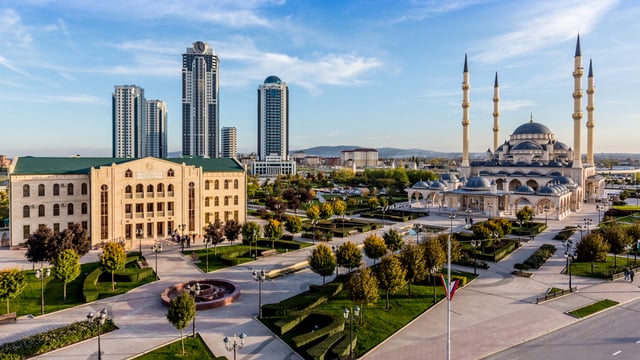
Grozny in 2013
The economic situation in Chechnya has improved considerably since 2000. According to the New York Times, major efforts to rebuild Grozny have been made, and improvements in the political situation have led some officials to consider setting up a tourism industry, though there are claims that construction workers are being irregularly paid and that poor people have been displaced.[126]
Chechnya's unemployment was 67% in 2006 and fell to 21.5% in 2014[127]
Total revenues of the budget of Chechnya for 2017 are 59.2 billion rubles. Of these, 48.5 billion rubles are so-called "gratuitous receipts" from the federal budget of the Russian Federation.
See also
Wildlife of Chechnya

